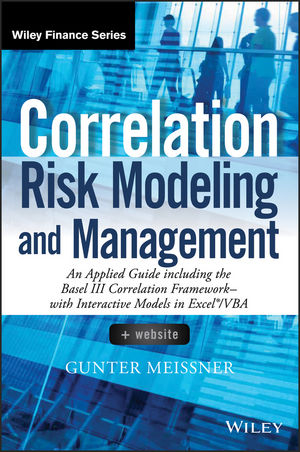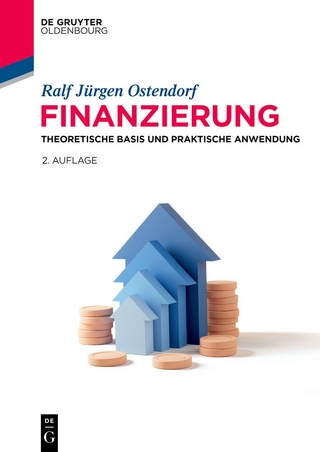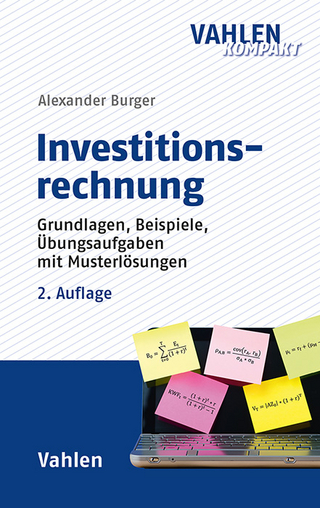
Correlation Risk Modeling and Management
John Wiley & Sons Inc (Verlag)
978-1-118-79690-0 (ISBN)
- Titel ist leider vergriffen;
keine Neuauflage - Artikel merken
Ideal for anyone studying for CFA, PRMIA, CAIA, or other certifications, Correlation Risk Modeling and Management is the first rigorous guide to the topic of correlation risk. A relatively overlooked type of risk until it caused major unexpected losses during the financial crisis of 2007 through 2009, correlation risk has become a major focus of the risk management departments in major financial institutions, particularly since Basel III specifically addressed correlation risk with new regulations. This offers a rigorous explanation of the topic, revealing new and updated approaches to modelling and risk managing correlation risk.
Offers comprehensive coverage of a topic of increasing importance in the financial world
Includes the Basel III correlation framework
Features interactive models in Excel/VBA, an accompanying website with further materials, and problems and questions at the end of each chapter
GUNTER MEISSNER, PH.D., heads Dersoft (www.dersoft.com), the software company behind TradeSmart, a software package that derives futures, options, and swaps prices and risk parameters. In addition, he runs a hedge fund (www. cassandracm.com), and is Adjunct Professor of Mathematical Finance at NYU. Dr. Meissner joined Deutsche Bank in 1990, where he traded interest rate futures, swaps, and options in Frankfurt and New York. He became Head of Product Development in 1994, responsible for originating algorithms for new derivatives products. In 1995/1996 Dr. Meissner became Head of Options at Deutsche Bank Tokyo. From 1997 to 2007, he was Professor of Finance at Hawaii Pacific University. From 2008 to 2013 he was Director of the Master in Financial Engineering program at the Shidler College of Business at the University of Hawaii. The author of numerous published papers on derivatives in international journals, Dr. Meissner also is a frequent speaker at international conferences and seminars and the author of four other books, including The Definitive Guide to CDOs: Application, Pricing, and Risk Management.
Preface xiii
Acknowledgments xvii
About the Author xix
CHAPTER 1
Some Correlation Basics: Properties, Motivation, Terminology 1
1.1 What Are Financial Correlations? 1
1.2 What Is Financial Correlation Risk? 2
1.3 Motivation: Correlations and Correlation Risk Are Everywhere in Finance 5
1.4 How Does Correlation Risk Fit into the Broader Picture of Risks in Finance? 24
1.5 A Word on Terminology 33
1.6 Summary 34
Appendix 1A: Dependence and Correlation 35
Dependence 35
Correlation 36
Independence and Uncorrelatedness 37
Appendix 1B: On Percentage and Logarithmic Changes 38
Practice Questions and Problems 39
References and Suggested Readings 40
CHAPTER 2
Empirical Properties of Correlation: How Do Correlations Behave in the Real World? 43
2.1 How Do Equity Correlations Behave in a Recession, Normal Economic Period, or Strong Expansion? 43
2.2 Do Equity Correlations Exhibit Mean Reversion? 46
2.3 Do Equity Correlations Exhibit Autocorrelation? 50
2.4 How Are Equity Correlations Distributed? 51
2.5 Is Equity Correlation Volatility an Indicator for Future Recessions? 52
2.6 Properties of Bond Correlations and Default Probability Correlations 53
2.7 Summary 54
Practice Questions and Problems 55
References and Suggested Readings 55
CHAPTER 3
Statistical Correlation Models—Can We Apply Them to Finance? 57
3.1 AWord on Financial Models 57
3.2 Statistical Correlation Measures 60
3.3 Should We Apply Spearman’s Rank Correlation and Kendall’s t in Finance? 65
3.4 Summary 66
Practice Questions and Problems 67
References and Suggested Readings 68
CHAPTER 4
Financial Correlation Modeling—Bottom–Up Approaches 69
4.1 Correlating Brownian Motions (Heston 1993) 69
4.2 The Binomial CorrelationMeasure 72
4.3 Copula Correlations 74
4.4 Contagion Correlation Models 88
4.5 Summary 90
Appendix 4A: Cholesky Decomposition 91
Example: Cholesky Decomposition for Three Assets 92
Appendix 4B: A Short Proof of the Gaussian Default
Time Copula 93
Practice Questions and Problems 93
References and Suggested Readings 94
CHAPTER 5
Valuing CDOs with the Gaussian Copula—What Went Wrong? 101
5.1 CDO Basics—What Is a CDO? Why CDOs? Types of CDOs 101
5.2 Valuing CDOs 105
5.3 Conclusion: The Gaussian Copula and CDOs—What Went Wrong? 113
5.4 Summary 115
Practice Questions and Problems 116
References and Suggested Readings 117
CHAPTER 6
The One–Factor Gaussian Copula (OFGC) Model—Too Simplistic? 119
6.1 The Original One–Factor Gaussian Copula (OFGC) Model 121
6.2 Valuing Tranches of a CDO with the OFGC 122
6.3 The Correlation Concept in the OFGC Model 128
6.4 The Relationship between the OFGC and the Standard Copula 131
6.5 Extensions of the OFGC 132
6.6 Conclusion—Is the OFGC Too Simplistic to Evaluate Credit Risk in Portfolios? 135
6.7 Summary 138
Practice Questions and Problems 139
References and Suggested Readings 140
CHAPTER 7
Financial Correlation Models—Top–Down Approaches 143
7.1 Vasicek’s 1987 One–Factor Gaussian Copula (OFGC) Model Revisited 144
7.2 Markov Chain Models 146
7.2.1 Inducing Correlation via Transition Rate Volatilities 146
7.3 Contagion Default Modeling in Top–Down Models 150
7.4 Summary 153
Practice Questions and Problems 154
References and Suggested Readings 154
CHAPTER 8
Stochastic Correlation Models 157
8.1 What Is a Stochastic Process? 157
8.2 Sampling Correlation from a Distribution (Hull and White 2010) 159
8.3 Dynamic Conditional Correlations (DCCs) (Engle 2002) 160
8.4 Stochastic Correlation—Standard Models 162
8.5 Extending the Heston Model with Stochastic Correlation (Buraschi et al. 2010; Da Fonseca et al. 2008) 168
8.6 Stochastic Correlation, Stochastic Volatility, and Asset Modeling (Lu and Meissner 2012) 172
8.7 Conclusion: Should We Model Financial Correlations with a Stochastic Process? 176
8.8 Summary 177
Practice Questions and Problems 177
References and Suggested Readings 178
CHAPTER 9
Quantifying Market Correlation Risk 181
9.1 The Correlation Risk Parameters Cora and Gora 182
9.2 Examples of Cora in Financial Practice 184
9.3 Cora and Gora in Investments 187
9.4 Cora in Market Risk Management 189
9.5 Gora in Market Risk Management 197
9.6 Summary 198
Practice Questions and Problems 199
References and Suggested Readings 200
CHAPTER 10
Quantifying Credit Correlation Risk 201
10.1 Credit Correlation Risk in a CDS 203
10.2 Pricing CDSs, Including Reference Entity–Counterparty Credit Correlation 205
10.3 Pricing CDSs, Including the Credit Correlation of All Three Entities 215
10.4 Correlation Risk in a Collateralized Debt Obligation (CDO) 227
10.5 Summary 231
Practice Questions and Problems 232
References and Suggested Readings 233
CHAPTER 11
Hedging Correlation Risk 235
11.1 What Is Hedging? 235
11.2 Why Is Hedging Financial Correlations Challenging? 238
11.3 Two Examples to Hedge Correlation Risk 239
11.4 When to Use Options and When to Use Futures to Hedge 247
11.5 Summary 248
Practice Questions and Problems 249
References and Suggested Readings 249
CHAPTER 12
Correlation and Basel II and III 251
12.1 What Are the Basel I, II, and III Accords? Why Do Most Sovereigns Implement The Accords? 251
12.2 Basel II and III’s Credit Value at Risk (CVaR) Approach 252
12.3 Basel II’s Required Capital (RC) for Credit Risk 258
12.4 Credit Value Adjustment (CVA) Approach without Wrong–Way Risk (WWR) in The Basel Accord 261
12.5 Credit Value Adjustment (CVA) with Wrong–Way Risk in the Basel Accord 264
12.6 How Do the Basel Accords Treat Double Defaults? 269
12.7 Debt Value Adjustment (DVA): If Something Sounds Too Good to Be True . . . 274
12.8 Funding Value Adjustment (FVA) 276
12.9 Summary 278
Practice Questions and Problems 280
References and Suggested Readings 280
CHAPTER 13
The Future of Correlation Modeling 283
13.1 Numerical Finance: Solving Financial Problems Numerically with the Help of Graphical Processing Units (GPUs) 283
13.2 New Developments in Artificial Intelligence and Financial Modeling 287
13.3 Summary 298
Practice Questions and Problems 300
References and Suggested Readings 300
Glossary 303
Index 315
| Erscheint lt. Verlag | 30.5.2014 |
|---|---|
| Reihe/Serie | Wiley Finance Editions |
| Verlagsort | New York |
| Sprache | englisch |
| Maße | 165 x 233 mm |
| Gewicht | 666 g |
| Themenwelt | Wirtschaft ► Betriebswirtschaft / Management ► Finanzierung |
| ISBN-10 | 1-118-79690-X / 111879690X |
| ISBN-13 | 978-1-118-79690-0 / 9781118796900 |
| Zustand | Neuware |
| Haben Sie eine Frage zum Produkt? |
aus dem Bereich


